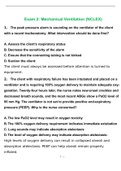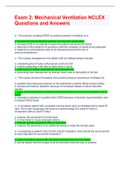Mechanical Ventilation NCLEX
Mechanical Ventilation NCLEX
All 14 results
Sort by
Exam 2: Mechanical Ventilation NCLEX Questions and Answers 2022
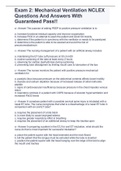
-
Exam 2: Mechanical Ventilation NCLEX Questions And Answers With Guaranteed Pass!!
- Exam (elaborations) • 13 pages • 2022
-
- $12.99
- 1x sold
- + learn more
a The purpose of adding PEEP to positive pressure ventilation is to a. increase functional residual capacity and improve oxygenation b. increase FIO2 in an attempt to wean the patient and avoid O2 toxicity c. determine if the patient is in synchrony with the ventilator or needs to be paralyzed d. determine is the patient is able to be weaned and avoid the risk of pneumomediastinum c The nursing management of a patient with an artificial airway includes a. maintaining the ET tub...
Exam 2: Mechanical Ventilation NCLEX Questions and Answers
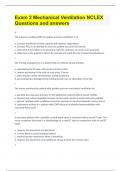
-
Exam 2 Mechanical Ventilation NCLEX Questions and answers
- Exam (elaborations) • 15 pages • 2023
-
- $12.99
- + learn more
a The purpose of adding PEEP to positive pressure ventilation is to a. increase functional residual capacity and improve oxygenation b. increase FIO2 in an attempt to wean the patient and avoid O2 toxicity c. determine if the patient is in synchrony with the ventilator or needs to be paralyzed d. determine is the patient is able to be weaned and avoid the risk of pneumomediastinum c The nursing management of a patient with an artificial airway includes a. maintaining the ET tube ...
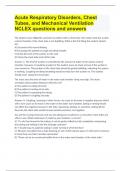
-
Acute Respiratory Disorders, Chest Tubes, and Mechanical Ventilation NCLEX questions and answers 2023/24
- Exam (elaborations) • 12 pages • 2023
-
- $14.49
- + learn more
The student nurse diligently assesses her patient with a chest tube. She notices that the suction control chamber of the chest tube is not bubbling. What is the first thing this student should do? A) Document this normal finding B) Encourage the patient to cough and deep breathe C) Check the level of the suction on the wall D) Clamp the chest tube and call for help Answer: C. The level of suction is controlled by the amount of water in the suction control chamber. However, it would be prude...
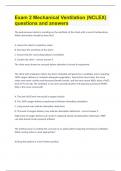
-
Exam 2 Mechanical Ventilation (NCLEX) questions and answers
- Exam (elaborations) • 21 pages • 2023
-
- $15.99
- + learn more
The peak pressure alarm is sounding on the ventilator of the client with a recent tracheostomy. What intervention should be done first? A. Assess the client's respiratory status B. Decrease the sensitivity of the alarm C. Ensure that the connecting tubing is not kinked D. Suction the client A The client must always be assessed before attention is turned to equipment. The client with respiratory failure has been intubated and placed on a ventilator and is requiring 100% oxygen del...
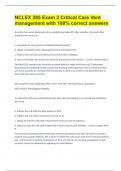
-
NCLEX 285 Exam 2 Critical Care Vent management with 100% correct answers
- Exam (elaborations) • 18 pages • 2023
-
- $12.99
- + learn more
To verify the correct placement of an endotracheal tube (ET) after insertion, the best initial action by the nurse is to a. auscultate for the presence of bilateral breath sounds. b. obtain a portable chest radiograph to check tube placement. c. observe the chest for symmetrical movement with ventilation. d. use an end-tidal CO2 monitor to check for placement in the trachea. ANS: D End-tidal CO2 monitors are currently recommended for rapid verification of ET placement. Auscultation for b...
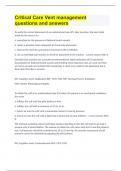
-
Critical Care Vent management questions and answers
- Exam (elaborations) • 12 pages • 2023
-
- $14.49
- + learn more
To verify the correct placement of an endotracheal tube (ET) after insertion, the best initial action by the nurse is to a. auscultate for the presence of bilateral breath sounds. b. obtain a portable chest radiograph to check tube placement. c. observe the chest for symmetrical movement with ventilation. d. use an end-tidal CO2 monitor to check for placement in the trachea. ANS: D End-tidal CO2 monitors are currently recommended for rapid verification of ET placement. Auscultation for bil...
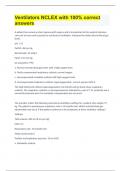
-
Ventilators NCLEX with 100% correct answers
- Exam (elaborations) • 27 pages • 2023
-
- $13.99
- + learn more
A patient has coronary artery bypass graft surgery and is transported to the surgical intensive care unit at noon and is placed on mechanical ventilation. Interpret the initial arterial blood gas levels pH: 7.31 PaCO2: 48 mm Hg Bicarbonate: 22 mEq/L PaO2: 115 mm Hg O2 saturation: 99% a. Normal arterial blood gas levels with a high oxygen level b. Partly compensated respiratory acidosis; normal oxygen c. Uncompensated metabolic acidosis with high oxygen levels d. Uncompensated respirator...
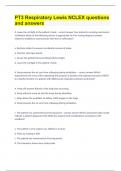
-
PT3 Respiratory Lewis NCLEX questions and answers
- Exam (elaborations) • 28 pages • 2023
-
- $14.49
- + learn more
d. Leave the call light in the patient's hand. Your patient is receiving mechanical ventilation which of the following actions is appropriate for the nursing diagnosis anxiety related to inability to communicate with fear of suffocation? a. Restrain patient to prevent accidental removal of tubes. b. Monitor vital signs hourly. c. Assure the patient that everything will be alright. d. Leave the call light in the patient's hand. d. Peep prevents the air sacs from collapsing during ...

That summary you just bought made someone very happy. Also get paid weekly? Sell your study resources on Stuvia! Discover all about earning on Stuvia

